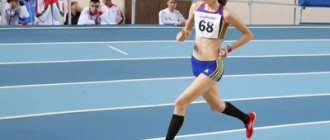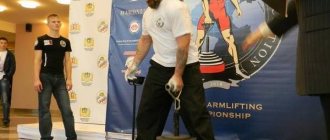Standing out among the disciplines of athletics, long-distance running is the most common and popular.
In addition to professionals, this type of running is used by ordinary people who want to be beautiful, resilient and healthy. After all, during running, many muscle groups and organs are involved.
Also happens:
- Increased endurance for the lungs and heart.
- The functioning of the digestive system improves.
- The blood vessel system becomes more developed.
- Distance running is measured by either distance or time.
What affects the speed of long-distance running?
Human speed is established in childhood, between the ages of 7 and 11 years. To do this, it is not necessary to engage in athletics; any sport develops speed qualities.
At an older age, speed can also be improved through training, but this is much more difficult. Over long distances, the following factors influence running speed:
- MOC (maximum oxygen consumption) indicator - you can improve it by training in conditions of lack of oxygen or hypoxia. This effect can be achieved when running in the mountains at high altitudes.
- Regular training helps increase and maintain speed levels. If you stop training for a long time, the speed will go away.
- Good recovery is necessary for the body to give all its best and perform speed work at the maximum level.
- Speed development exercises are recommended to be performed at 90-95% of your maximum heart rate.
- Wearing comfortable, tight-fitting clothing that doesn't restrict your movement will also help you run faster.
- Shoes with shock-absorbing soles return the force of each previous step, allowing you to waste less energy and run faster.
What happens in the body?
Now we know why to include long running in your training plan. Let's figure out what processes a long run at a low heart rate triggers in our body:
- First of all, as with any aerobic exercise, the cardiovascular + musculoskeletal + respiratory systems develop. This contributes to the growth of ANSP, IPC;
- The network of capillaries and collateral vessels of the muscles increases;
- The number of energy stations of any cell - mitochondria - increases. Moreover, an experiment with mice showed: the number of mitochondria begins to slowly increase from the first 30 minutes of exercise. Time to increase mitochondria by 2 times - from 1.5 hours! This is how long a long run ideally takes;
- The number of slow muscle fibers increases. At the same time, the economy (efficiency) of running increases;
- The stabilizer muscles of the foot develop, especially during long runs over rough terrain;
- A marathon can be really stressful for a beginner! You need to start preparing your nervous system in advance. A properly designed training plan including long-term training will improve the adaptability of the central nervous system.
What are the benefits of long-distance running?
As mentioned above, long-distance running develops many qualities and benefits the body. Let's take a closer look at the benefits that a person receives from regular running training.
Improves blood circulation in the body
The structure of the human body is such that most capillaries are in a vertical position. This prevents blood from flowing quickly through them. If a person leads a sedentary and sedentary lifestyle, the blood in the vessels stagnates and stretches the walls. For this reason, the heart does not receive enough oxygen and hypoxia develops, as well as other concomitant diseases.
Strengthening the body
Running workouts speed up your metabolism. The body quickly cleanses itself of harmful and unnecessary products, saturates the blood with oxygen and receives a boost of energy. With regular exercise, you will feel light, both physically and psychologically.
Strengthening the muscle corset
When running, many muscle groups are used. Regular intense training has a positive effect on body contour and muscle mass gain. If you combine them with proper nutrition, the absence of bad habits and a healthy sleep pattern, the effect will be even greater.
Positive effect on the nervous system
During depression and bad mood, many advise to distract yourself by playing sports or physical activity. Running really allows you to clear your head, improve concentration and understand your own thoughts. Psychologists recommend running for lazy people who find it difficult to organize themselves.
Promotes weight loss
One of the most pressing problems of the 21st century remains excess weight. Running, like any cardio workout, is a good way to lose extra pounds. In one hour of intense training, a person can lose up to 800-900 kcal.
Improves the efficiency of the heart muscle
While running, the heart actively pumps oxygenated blood throughout the body. Medium-intensity cardio training lasting 30-40 minutes best trains the heart muscle, allowing it to adapt to economical and efficient work.
The benefits and harms of slow running
Slow running helps to activate the most important metabolic processes. This sport:
- immunity is strengthened;
- digestion is normalized;
- vision improves;
- stimulates the body's rejuvenation processes.
Read: The benefits of walking on all fours for weight loss
Every runner is familiar with the elevated emotional state after a race, which is explained by the release of a generous portion of “happiness” hormones into the blood. These hormones:
- treat insomnia;
- lift your spirits;
- increase stress resistance;
- improve cognitive abilities.
Slow running is an effective method of preventing osteoporosis, scoliosis, and increases the sensitivity of bone tissue to minerals, including calcium, phosphorus and magnesium.
Light jogging is recommended for women to improve the condition of their skin, hair and nails, normalize weight and quickly get rid of cellulite.
To summarize, we can say that slow running is practically harmless. If you have a cold with an elevated body temperature, you should not do it.
How can long-distance running harm you, what are the contraindications?
Running has its contraindications, which we will discuss below.
- Great load on the joints of the legs. When using long-distance running as a way to lose weight, be careful: putting too much stress on your legs can lead to joint pain and premature wear;
- It is not recommended to engage in long-distance running if you have cardiovascular diseases;
- Chronic diseases and other pathologies are also contraindications for running;
- Osteochondrosis;
- Gastrointestinal diseases in the acute stage;
- Mental illnesses in the acute stage;
- Liver diseases, if they are accompanied by pain syndromes;
- Respiratory diseases such as asthma.
What is the best time to run?
There is no specific best time for everyone, the timing of training varies from person to person. The body must awaken; for most people, training in the morning causes great difficulties, since the body has not yet recovered from sleep. It is considered to be the most effective training in the daytime and evening, especially aimed at interval, sprint, and shuttle running. Jogging is suitable as a health-improving workout in the morning to boost your energy levels and improve your health.
How to learn to run long distances?
You can show good results when running long distances only with regular training. There are four main methods with which you can prepare your body and qualitatively improve your results.
- Distance training. The most serious stage of preparation, accounting for approximately 70-80% of the total load. The idea is simple - run at the highest possible speed for 30-50 minutes.
- Threshold training. The essence of these classes is to repeat running at a distance of 50 to 1500 meters with breaks of about 1 minute. During such training, anaerobic metabolism occurs - a situation in which the body learns to cope with physical activity in the absence of oxygen.
- Interval training. The key is to run at a jagged pace. First, a person runs at his usual pace, then at some point he accelerates for a short period of time and again returns to his usual running rhythm.
- Speed training. The distance is divided into segments equal to approximately 400-500 m. The task is to run each of them faster than during the race over the entire distance.
Read more about running for beginners in the article How to start running.
Running tactics
As an example, I will give three well-known tactics in stayer running. Each of the options was tested in competitions. The optimal tactics can be determined based on personal preferences and indicators that depend on individual characteristics.
Behind the opponent's back . After the start, try to spot an athlete who is capable of showing a good result and follow him the entire distance. There is a chance that the choice will be made incorrectly and then you can cling to a runner who is head and shoulders above your skill and not maintain the pace, or, on the contrary, find that the athlete is clearly behind the group.
Personal experience has shown that tactics work with an error. Once, having caught on to one of the participants, after 3000 meters I noticed that I was stepping on my heels. Having accelerated in the last 5 laps, I won about 300 meters from him, but lost the same amount to the leader.
Leadership. If you have self-confidence, then you can try to pull a group of participants along with you. In this case, two things can happen:
- Your opponents will be forced to run after you as long as they have enough strength, and then noticeably lag behind.
- Among the pursuers there will be a participant who will be much more resilient and will confidently bypass at the end of the distance.
Again from personal experience. I had seen some of the participants before, knew approximately their results and was well prepared for the race. At first, I held the lead of 50-60 meters in the distance. In the last 200 meters, the opponent began to sharply reduce the gap and almost leveled out, which forced him to increase the pace to the limit. After finishing, I was once again convinced that interval running is very useful even over long distances.
Ragged run. In the mid-20th century, the Frenchman Gordon Pirie shone, who was the first to use ragged running as a tactic. He accelerated from the beginning of the distance to a pace close to a sprint and maintained it for 200 meters, then lowered the pace to a level below average. Then the acceleration was repeated. Throughout the distance, the rivals repeated Piri’s actions as long as they had enough strength, and then fell behind.
The good thing about this tactic is that the ability to withstand significant changes in tempo almost guarantees victory. However, the functional state of the body suffers and wears out faster. It is believed that it was precisely the running tactics that did not allow Gordon Pirie to raise a generation of athletes during his coaching activities. He lived to be 60 years old.
The tactics of running in segments are also used, when the athlete sets himself the task of running each part of the distance in a set time. Typically, similar tactics are used during competitive training. That is, the athlete participates in competitions, but his task is not to win, but to complete the task set by the coach.
Long distance running technique
Long-distance running requires the athlete to have a serious level of physical fitness, good endurance and knowledge of the basic principles of running technique, which are described in detail below.
In general, running can be divided into three stages:
- Start, starting acceleration - the start of the run, the athlete starts and begins to pick up speed. In most cases, the highest speed over a distance occurs in the first 100 meters, then it gradually drops and remains at a certain level. If running takes place in competitions, it is important to take comfortable positions in the leading group, but there is another strategy - to save energy and run in the pursuing group;
- Running along a distance - this stage can be characterized by a constant speed of movement without noticeable accelerations. At running competitions, leaders constantly change, giving each other the leading position;
- Finishing – begins 40-100 meters before the end of the race. Athletes gather their remaining strength into a fist and try to squeeze the maximum out of their body, developing the speed available to them.
Running technique is extremely important; it allows you not to waste energy and avoid injuries.
Correct foot placement
There are three options for positioning your feet when they touch the ground:
- On the toe – the athlete’s foot is lowered onto the metatarsus or ball of the foot;
- On the heel - the foot falls on the heel;
- On the foot - the entire foot touches the ground at the same time.
The placement of the legs is selected individually, depending on anthropometric data and comfort.
Breathing technique
Long distance running requires proper breathing technique. It is recommended to inhale deeply, using the diaphragm. The breathing rate should be uniform as you go through the distance.
While breathing, try to use your stomach: as you inhale, it should protrude forward, and as you exhale, it should return back.
Remember an important rule - the exhalation should always be shorter than the inhalation.
The best breathing system for long distance running is to inhale for two steps and exhale for four.
Body position and hand movement
When running long distances, your torso should be in the same position almost always. The back is straight, slightly tilted forward at an angle of about 5 degrees. This is necessary to give the body inertia of movement.
During the distance, the head should look exclusively forward (if the running is not on rough terrain), and should not rotate or tip over.
The arms should be bent at the elbows and move along with the steps of the legs. Elbows should point outward. If you move your arms correctly, it will give you acceleration and increase your cadence.
Movement is life. Running is good for the human body, making it stronger, more resilient, faster and more focused. We hope our material was useful to you and you learned what long-distance running develops, and also took note of the training recommendations.
Sprint Features
Like any other sport, sprinting has its own unique characteristics. They are as follows:
- At the start, you need to place your feet correctly, because this directly affects the strength of the push. It plays an important role for overclocking.
- During the initial acceleration stage, runners increase their frequency and stride size, which helps achieve sprinting dynamics.
- When gaining a high speed of movement, athletes lean slightly forward, correctly distributing body weight.
- Hands play an important role in the race. Athletes make energetic pushes with them, which also increases speed.
- In the middle of the distance, sprinters run almost on their toes, slightly tilting their body forward. This helps you not lose speed.
- For sprinters, good reaction and coordination are important. Composure is an undeniable emotion before the finish line.
Despite the fact that sprinting is one of the fastest types of running, it takes a lot of effort to cover the distance. Typically, tracks range from 60 to 400 meters in length. Athletes running a 400-meter race are called long sprints. A certain amount of time is allotted to cover each distance, but the fewer seconds you spend on the race, the higher the result will be.
Best posts about running
- How to start running - running tips for beginners, recommendations and common mistakes of beginning runners
- How to breathe correctly when running - breathing technique during training
- How many calories are burned when running and how long should you run to lose weight?
- My side hurts when running – should I worry?
- Is knee pain after running a sign of a serious illness?
- Running in the morning - how to run correctly in the morning, benefits and effectiveness in losing weight
- Have you heard about the obstacle race “Race of Heroes”? We tell you what it is and how to take part
Long Run Training Plan Options
Up to 10 km
For medium + long distances up to 10 km, long running is an opportunity to increase endurance and prepare the body psychologically + physically for competitions.
However, your training plan should include no more than 1 long running session per week.
It is correct to use long distances for training only in the base period.
For 3-5 km - no later than 4 weeks before the competition, for 10 km - 3 weeks.
Half marathon
The half marathon distance allows you to use long running 1 time per week during the base/competition period, but no later than 2 weeks before the start.
Such a load will prepare the nervous system for competitions without causing physical harm to the body.
Marathon running
Long runs at low heart rates make the only exception when training for a marathon. 4 weeks before the start, you need to complete a control long run at your target marathon pace. This is very important: the body must prepare not just for a long run, but to “maintain” the desired pace.
Jogging is then reintroduced into the training plan to allow the body to recover before the race. Gradually, by the time you start, the training intensity is reduced by 15% every week.
It is for the marathon that long-term training is of paramount importance. During a long run, marathon runners train to eat/drink while running, maintain the pace, and do the final acceleration.
Preparing for an ultramarathon
Each ultramarathon runner individually creates his own training program. Here it is already more difficult to give specific recommendations.
The pace can be from 60-85% of the target + competitive. Ultramarathon participants often use “super series” of long running in preparation.
These are workouts of more than 1.5 hours of varying intensity, which follow each other for 2-4 days in a row. Correctly chosen load allows you to improve your health before very long distances.
Development of the respiratory system
For the effective development of the respiratory system, just running will be enough, but if you decide to run more intensely, then it is recommended to use several exercises, among which stand out:
- Distance training. This type of training should make up more than 50% of the total. It consists of light moderate running for half an hour, with a gradual increase.
- Threshold training. Designed to work under conditions of long-term oxygen deficiency, which increases muscle endurance in extreme conditions. Performed in 1 km segments as quickly as possible, with a break between approaches of no more than 2 minutes. The number of approaches depends on experience, preparedness and well-being.
- Interval training. Similar to the tactics of jerky running, it is performed at an average distance of up to 5 kilometers with periodic acceleration every 50 meters for 1-2 minutes.
- Speed training. Performed over a short distance of 400 meters, one track and field lap. The goal of the training is to gradually increase the lap speed.
It is the combination of different types of training that allows you to optimally and fully develop the respiratory system, which works in different modes and varying degrees of load.
Originally posted 2018-01-09 08:22:15.
Basic mistakes
Ignoring the basic rules and techniques of long-distance running leads to a decrease in performance and abandonment of leading positions.
The main mistakes (excluding improper selection of equipment and shoes) are:
- Prolonged segment of starting acceleration.
- Acceleration is too fast.
- Confused, irregular breathing or breathing incompletely.
- Incorrect positioning of the body, arching in the lower back or strong tilt of the body forward.
- Inadequate arm range or angle.
- Steps too wide when covering the distance.
Excessive physical activity on the eve of a race has a negative impact on your results. Therefore, most athletes, on the eve of competitions, arrange a “day of silence” for the purpose of complete relaxation.










